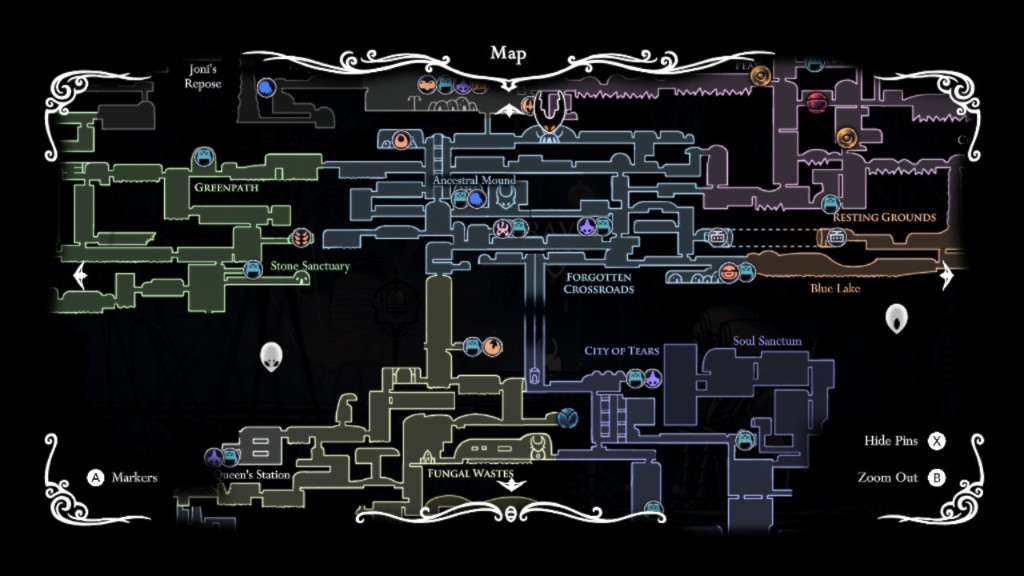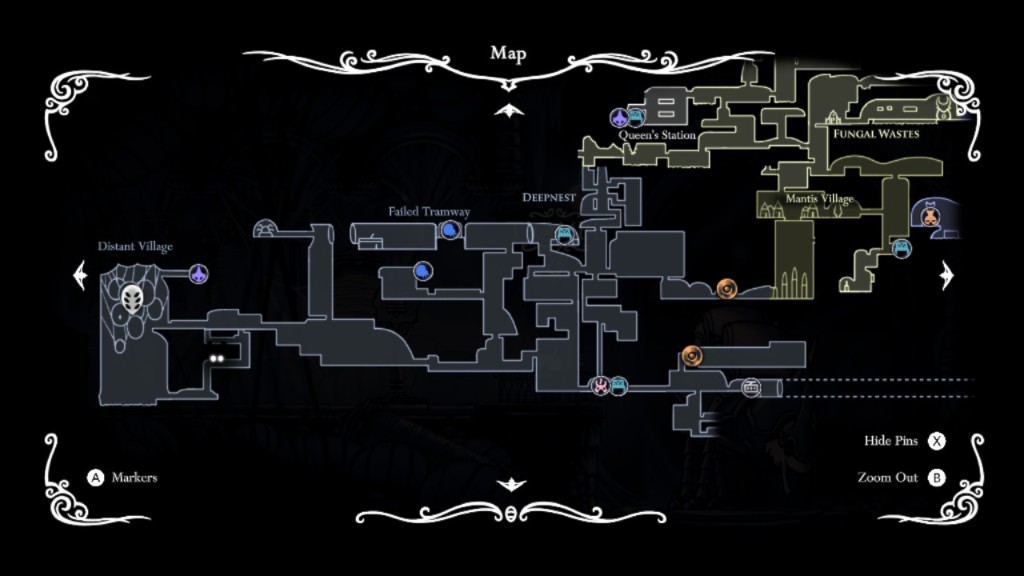We have a podcast episode dedicated to video game maps, so if you love them as much as we do head over here for a listen, or check out my new post on maps in God of War. In it we discuss that maps and map reading are something video games struggle with. Generally, the approach is to be a hyper-detailed Google Maps version of reality regardless of whether you are exploring a mountain in Monster Hunter World, where the most high tech bit of kit you have is a staff that shoots a beetle, but you still see yourself and others running across a scroll, tracking monster movement and every rock and fauna around. I don’t like to use the words ludo-narrative dissonance, but I will.
In other instances, you can give a map a pass if the game world is mildly modern/futuristic. However, even in those examples the level of detail and player tracking mean that there is no joy in using the map. Instead, it’s a waypoint finder, that takes a lot of the mystery and adventure out of the experience. You go on it see where the next ‘thing’ is and follow it from place to place with, for the most part, a clear idea of what to expect.

And then you have Hollow Knight. A 2D platformer that succeeds in being one of the most engaging map reading experiences in video games. Hollow Knight manages an incredible amount, especially when you consider that most maps allow for three-dimensional navigation. At this point, you probably already know that I’m going to say something along the lines of, map reading in Hollow Knight is beautiful, and you would be correct in that assumption.

So what makes this 2D map so magical? Firstly, Hollow Knight is a game all about exploring the depths a place call the Hollownest. Each area in Hollow Knight is distinct not only in theme but monsters and challenges. All of this is tied together through an ever expanding map.
Upon entering a new area, you have no map and if you try to open the map screen it will be blank. This doesn’t stop you exploring but you can’t help but feel lost and a sense of trepidation as move through this uncharted zone. However, once you find the cartographer in each area, he will give you a partial map but the majority of it is blank, ready for you to explore and complete. Early on in your Hollow Knight map reading career, you are given a crest (these are specific perks or powers that you can equip) that means that you can see your location on the map. However, you have a very limited number of slots and if you waste on something as simple as your map location, you will miss out on everything Hollow Knight has to offer.

Immediately, you are thrown into a world either without a map or with very little information about your location. Through your exploration and familiarisation, each location will have a map created in the game and in your head – just like real life (not a joke). As you explore places the Forgotten Crossroads, you will learn the quickest way to a bench (save/heal point) or to the various other areas in the game. Occasionally, you might check the map to see where the next turn is or which path to take and this means that the map takes an active role in how you play the game.
It is this active role that makes map reading in Hollow Knight feel so natural and similar to real life map reading, while at the same time smoothing out the experience. Filling in all the hidden areas is incredibly satisfying and plotting a route from one side of the world and then referring back to the map at various crossroads, means you are always thinking about the map and where you are.

You might take a wrong turn, need to check the map, realise you were actually in a different place to where you thought you were, stumble into a location you’d never been before and start a whole new adventure. In Hollow Knight, rather than using the map as a way of getting from A to B, you use the map as part of the adventure, it’s one of your most valuable tools and you never take it for granted.
When you have no map and no idea where you are going in a new area, the world feels dangerous and unknowable. When you finally find that map and see all the areas yet to be explored, finding and uncovering their secrets is exciting. Watching the world of Hollow Knight sprawl out from your initial starting location to cover places you couldn’t even have dreamt of at the start is a truly breathtaking experience. All the while, each area has a theme and colour that is mirrored in the maps you make along the way.

This means that you instantly know when you enter a new area. When you go from the Forgotten Crossroads to the Fungal Wastes, you will see the shift in the theme of the world and your map. This helps you learn how the world links together and means that when you are making that map in your head or open up the one in-game, you understand where you are much easier.

And it is this ease that makes Hollow Knight’s map reading so enjoyable. I’ve done map reading in real life. It is hard. You need to know which way is North, which path takes you to which destination and taking a wrong turn is, rather than leading to a secret location, just annoying. In Hollow Knight this is never the case. You know which is left and right and there is no North, only up and down. This means finding your bearings and using the map is a fun addition to an already tremendously well-crafted game, rather than a gimmick that slows progress or frustrates the player.
The map brings Hollow Knight full circle, narratively as well. This is a game about exploring the unknown, uncovering a secret and hidden past. It is about the danger of what awaits you down in Hollow Nest but also about bringing hope and salvation what remains. The map encapsulates these themes as you start with the unknown and slowly uncover and fill in the map. If Hollow Knight had gone permanently giving you the ability to know your exact location and always gave you a map of an area upon entering it, this game would not be so effective and some of these narrative themes would be lost.

Hollow Knight is simultaneous one the of the best Metroidvania and map reading games I’ve ever played. It makes everything feel effortless and easy, while at the same time having some of the most challenging boss fights you’ll find anywhere. If you haven’t picked up Hollow Knight yet and any of this sounds even remotely interesting, then don’t wait for a waypoint, grab yourself a copy.
Thank you so much for reading. This one took a while and hopefully I’ve articulated one of the reasons why I love Hollow Knight. If you want more video games, then why not read Gav’s article on Necrobarista. Or if you want some books, then read my recent review of Tales of Heresy.
Here are our standard plugs: our Amazon affiliate link to give us a little kickback on purchases, and our Ko-Fi, if you’re an extraordinarily kind human and want to directly chuck us some money. You can follow me on Twitter at @NevadaDru, and the site’s at, @bitspluspieces.
I don’t think I can recommend a game more highly than Hollow Knight, if it came out this year it would definitely be my game of the year.


I’m playing Hollow Knight for the first time. On the NSwitch.
I like that the map is a tool, how important and effective it will be, it’s up to you, treat it like some general representation of the level itself, and won’t give you clear answer where you supposed to go next. It won’t give you an answer and reveal all of the level secrets just like that, when you’re stuck, which in many titles just happens because the game where you have to think is to much hassle and not an option!
And because the map is updated over the tube, it doesn’t mean the map in the game will be flawless and without errors! Before exploring some place it will look on the map, like just some basic, empty chamber without any exit /corridors to it. But it doesn’t mean there isn’t any, more likely you didn’t found a passage yet! Updating the map in the Hollow Knight can show you how the progress and exploration in this game really looks like. Amazing.
Other great use of the map and good implementation in the exploration aspects of the game can be found in Legend of Zelda: Breath of the Wild. I love that the actual map works like the real one, with detail look, proper topography and lines showing height change. Good for looking for a safe way or some hidden place in the general. And there’s no fancy GPS use, drawing the most optimal route to objective. This is your job, on how you gonna approach it.
LikeLiked by 1 person
I still need to play Breath of the Wild but I’m looking forward to getting round to it at some point. I’ve hear amazing things about the map, too.
I hope you enjoy your Hollow Knight playthrough. I played the Switch version as well.
LikeLike
Pingback: Leaders – It's not app-ening – Bits & Pieces
Pingback: London – Did you know poverty is bad? – Bits & Pieces
Pingback: Bookclubbing – Pokemon Adventures Volumes 1 – 4 – Bits & Pieces
Pingback: Bits & Pieces Podcast #26 – 2019 in Review – Bits & Pieces
Pingback: Mario + Rabbids Kingdom Battle & the joy of movement – Bits & Pieces
Hollow Knight and Zelda BOTW are without a doubt among the best map integrating games out there. I agree with everything in this article! For me, map/making should be a crucial part of a great game, especially in RPGs. I can only dream of a walking sim requiring cartographers’ tools, made for exploring, where you get enhance your in-game skills as an explorer, cartographer and can fine tune your tools.
LikeLiked by 1 person
A cartographer walking sim RPG would be amazing. I remember player Firewatch without the little GPS marker and thinking that could be expanded upon. You ever play that?
LikeLike
Pingback: What a little bug with a sword taught me about learning – ACRLog
Pingback: God of War’s fantastic, yet unreliable, map – Bits & Pieces
Pingback: Nevi’s Games of the Generation – Bits & Pieces
Pingback: Valfaris – Review – Heavy metal platformer – Bits & Pieces
Pingback: A Quick History of Fast Travel – Bits & Pieces
Pingback: MindSeize – Review – Pixel robots galore – Bits & Pieces
Pingback: Yoku’s Island Express – Review – Pinball platformer – Bits & Pieces
Pingback: Record of Lodoss War: Deedlit in Wonder Labyrinth – Review – Bits & Pieces